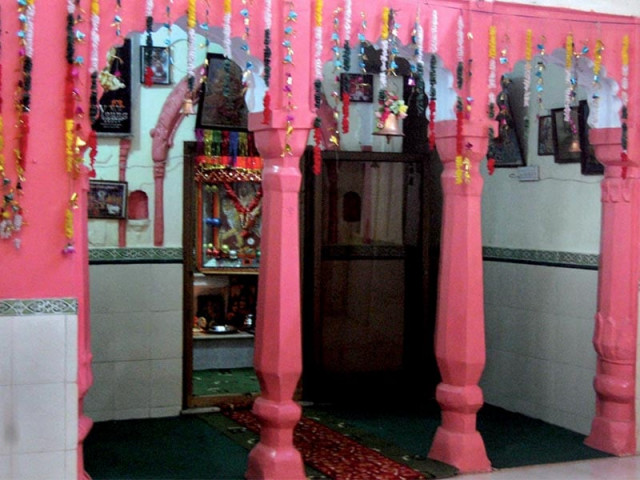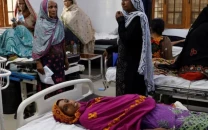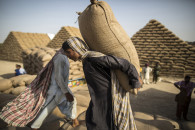Pindi’s architectural heritage - II: The sacred banyan tree and the neglected Hindu temples
Only the temple in Kabaari Bazaar remains in good condition.

Pindi’s architectural heritage - II: The sacred banyan tree and the neglected Hindu temples
As the tour through Rawalpindi’s intricate architecture with Professor Aziz Khan continues, the fish market in Saddar, with its grand entrance and long slabs, catches the eye.
It is covered by a concrete and steel canopy. It consists of a steel and concrete structure which has no internal columns and allows for wide entrances on each side. It is one of the most important sites representing European architecture. Legends say the market was built during the reign of Queen Victoria. The vendors in the market are concerned over the indifference that the Rawalpindi Cantonment Board (RCB) has shown towards the state of the market, which is in desperate need of maintenance.
“On the Bank Road, Saddar, where National Bank of Pakistan (NBP) exists today once stood Kirpa Ram Store. Adjacent to it was Kirpa Ram Compound where now exist many restaurants and fruit juice stalls,” the professor explains.
More important than the NBP building, however, is the Banyan Tree — considered sacred in Hinduism — that sits right in front. The tree is a direct descendant of the tree that provided the shade for meditations and marks the exact spot where the original tree stood, according to Aziz Khan.
Next to it is Ahata Fiiday Sahib. In fact, Pindi is full of Ahatas (compound): Ahata Mithu Khan, Nobat Roy, Khazan Chand, Sethan, Shamsabad, Boota Mal, Friday Sahib, and Karam Elahi, among others. “These buildings were set apart and adapted for keeping horses,” Khan says.
Next up on the tour is Ahata Khan Bahadur Ismail, which now accommodates auto workshops where a species of swallows called swifts have built their nests in the porch.
“Swifts build their nests at places where both sides are open to facilitate their flight. That’s why other ahatas have no swifts’ nests as they are now closed from all sides,” Aziz Khan says.
One building of Khan Bahadur Ismail on the Bank Road in Saddar is representative of Parthian (Iranian) architecture. According to Aziz, Lala Thakur Das Dharamshalas (rest houses/transit camps) near Railway Station on Dharampura Road, Koila Bazaar, were built to house the Hindu pilgrims arriving in Pindi from far-off cities like Karachi, who wanted to visit Badri Naath shrine in Kashmir. Hindu pilgrims hired tongas and reached Kashmir in just six days. Later on, Nanda Bus service, which started just after the First World War, ultimately replaced tongas.
A small pyramid-shaped Hindu mandir was in Sara-e-Baghat Ram. The structure still appears grand from afar, while the craftsmanship and tile work still intact gives a sense of its glorious past. The walls of the mandir have beautiful carvings, but its fine-looking architecture and appearance is in decay due to complete lack of care.
In Kanak Mandi, we go see the Ram Laila Mandir. There is still a remnant of the platform where on the occasion of Diwali and Dasehra Hindu devotees used to organise a Ramayan Natik (drama). The mandir now serves as residence for Kashmiri refugees. Climatic conditions have eaten into the structure and the rich carvings on the walls of the temple have slowly eroded.
“Unfortunately, some of these places are struggling for existence amid utter negligence of authority,” Aziz Khan laments.
Only one mandir in Kabaari Bazaar, Mandir Kaanji Mal Ujagar Mal Ram Richpal (named after three respected Hindu traders who funded the mandir in 1877), is in good condition. The president of Pakistan Hindu-Sikh Social Welfare Council, Jagmohan Kumar Arora, was also born in this mandir.
The mandir’s caretaker, Waqas, said all mandirs are under the control of the Auqaf Department and some of them have been given on lease to accommodate refugees, mostly from Kashmir. A little bit of official or non-official help will go a long way in preserving this heritage, he added.
Published in The Express Tribune, July 28th, 2012.



















COMMENTS
Comments are moderated and generally will be posted if they are on-topic and not abusive.
For more information, please see our Comments FAQ